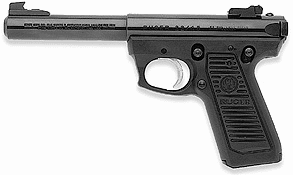By Syd

| Catalog
Number |
Model | Finish* | Barrel
Length |
Overall
Length |
Weight | Rear
Sight |
Front
Sight |
Price |
| P-512* | Bull | B | 5
1/2″ |
9
3/4″ |
35
oz |
Adj. | Fixed | 265.00 |
The Ruger 22/45 is a pistol that I often see questions about because it is billed as a “1911 trainer.” The question often posed is, which is better—a 22/45 or a conversion kit for the .45 which will allow it to shoot .22 LR? My own opinion on that one is that I’d rather have two guns than one and a half, but does the Ruger fulfill the function of being a 1911 trainer?
In my left hand I hold a mil-spec government model M1911A1 and in my right hand I hold a Ruger 22/45, model P-512 which is blued steel with a 5 ½” barrel. The M1911A1 weighs 39 oz. empty and the Ruger weighs 34 oz. so the heft is slightly different, and this is empty weight. Add 8 or 9 rounds of .45 ACP to the GM and it is significantly heavier. Another difference which is immediately obvious is that although the two pistols have the same barrel length, the Ruger is two inches longer than the GM due to the difference in the actions of the two pistols. (More on that later.) The sight radius of the Ruger is 1 ¾” longer than the GM.
The “trainer” aspect of the 22/45 comes into play with its controls and ergonomics. The safety and slide release are in the same locations on the 22/45 as they are on the GM. The safety sweeps down to go off like the GM, and like the GM, the safety will not move if the hammer is not cocked. Like the GM, the magazine will drop free when you push the magazine release. This works better once the gun is broken in and the magazines have had some use. The handle on the 22/45 is designed with same angles and shape as the GM although the handle of the 22/45 is slightly narrower than the GM with standard grips.
The trigger is an important area of comparison. The 22/45 has more take-up in the trigger before it breaks than the GM, about 1/8″ compared to the 1/16″ or less of the GM. The trigger break on the GM is somewhat heavier than the 22/45. I estimate that the trigger pull on the 22/45 is no more than 3 lbs. whereas the GM is about 5 lbs. I have found that in rapid-fire drills, the difference in take-up on the two triggers is noticeable and I have to remind myself to let out the trigger of the 22/45 just a bit further to allow it to reset.
Once you get inside of the two pistols, any resemblance between the two disappears. The 22/45 barrel and receiver is milled from a solid piece of steel and uses a blow-back bolt. The frame snaps and pins onto the barrel/receiver. Unlike the simple elegance of the M1911 trigger and sear assembly, the trigger and mainspring latch assembly of the 22/45 is a complex contraption that would make Rube Goldberg smile. In my opinion, it is the weakest design element of the 22/45. I won’t go into detail here on how to disassemble and reassemble the 22/45, but I will say that if you acquire one of these pistols without a manual, write to Ruger and get one because it will be next to impossible to guess the chicanery of the reassembly without the manual.
So how does it perform? The 22/45 is a tremendously accurate pistol. Since the barrel is fixed in place, there is no lock-up to affect accuracy. You will find your target work gratifying. It is reasonably reliable, especially if kept clean, but it can suffer jams when the breech begins to fill with that waxy junk which coats the bullets of most .22 LR ammunition. This is particularly true when it is new. It is a fun and economical gun to shoot and is an excellent trainer for youngsters as a first pistol. Generally, it costs less to buy than the 1911 conversion kits. The only problem reports I have received on them is that the sights can at times come loose and a drop of Loctite is often recommended on the screws which hold the sights in place.
Is it a trainer for action shooters who are using .45’s at IDPA and IPSC matches? Beyond the first shot, I would say not. No .22 LR can come close to approximating the recoil of a .45 and if a person is shooting rapid fire action shooting, the 22/45 would not train well for double taps and speed drills where quick recovery of the sight picture is required. But for basic marksmanship and learning the manual of arms for an M1911, the 22/45 is the next best thing to Old Slabsides.

Comments, suggestions, contributions? Let me know